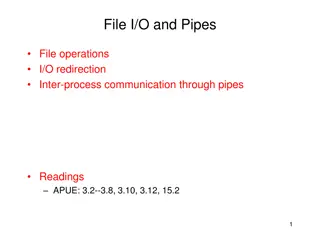Understanding Inter-Firm Relationships in Business Marketing
Appreciate the two-sided nature of relationships in business-to-business marketing and the importance of understanding buyer-seller dynamics. Explore the impact of network thinking on B2B relationships and the influence marketers have in managing these connections effectively.
Download Presentation
Please find below an Image/Link to download the presentation.
The content on the website is provided AS IS for your information and personal use only. It may not be sold, licensed, or shared on other websites without obtaining consent from the author. Download presentation by click this link. If you encounter any issues during the download, it is possible that the publisher has removed the file from their server.
- Inter-Firm Relationships
- B2B Marketing
- Buyer-Seller Dynamics
- Network Thinking
- Relationship Management
Presentation Transcript
Business to Business Business to Business Marketing Marketing Chapter 3 Inter-Firm Relationships and Networks
Learning outcomes Learning outcomes Appreciate that traditional approach to business marketing, based solely upon influencing organizational buying behaviour, naively assumes that the marketer is active while the customer is relatively passive Recognize that value creation in business-to-business exchange comes from a clear understanding of the relationship between buyer and seller Know what is meant by the relationship concept in B2B marketing
Learning outcomes Learning outcomes Know what variables affect business-to-business relationships Appreciate the range of tasks involved in continually managing a relationship Recognize the impact that the network concept has upon business-to-business marketing and the strategic imperative of network thinking
B2B Relationships B2B Relationships As well as an understanding of the behaviour of the buying company, business marketers also have to understand the relationship between the buying company and the selling company Relationships are two-sided; treating customers as passive recipients of the attentions of the marketer is a na ve view of business marketing and inherently flawed
Influencing the relationship Influencing the relationship Any ability a marketer has to influence the buyer depends on the nature of the relationship between the two parties and so must involve a clear understanding of what is possible within the relationship Means that rather than being solely preoccupied with the buying centre the marketer must analyze the relationship at large
Influencing the relationship Influencing the relationship A variety of theoretical viewpoints can be drawn upon to understand a relationship. However, it doesn t matter which perspective the marketer draws from so long as by doing so a clear understanding of what is happening in the relationship is derived. Decisions about the future of a relationship can only come about from such an understanding The business marketer strives for deep understanding of the current state of the relationship, of its likely future development, and of the process of value creation within the relationship
Figure 3.1: Matching uncertainties & abilities Figure 3.1: Matching uncertainties & abilities Greatest relationship value in the long term comes from the strongest match BUYER SELLER Problem-solving ability Transfer ability Demand ability Transfer ability Capacity uncertainty Application uncertainty Transaction uncertainty Need uncertainty Market uncertainty Transaction uncertainty (from Ford et al.,1998:18)
Figure 3.2: IMP Group Interaction model Environment Market structure Dynamism Internationalization Position in the marketing channel Social system Atmosphere Power/dependence Cooperation Closeness Expectations Product/service Information Short term Exchange episodes Organization Organization Financial Social Technology Structure Strategy Interaction process Individual Individual Aims Experience Institutionalisation Adaptations Long term Relationships (reproduced from Hakansson, 1982, p. 24)
Digital revolution impacting B2B relationships Type of Net amount of personal contact Relative importance to relationship exchange over time establishment and maintenance over time Product/ service Declining further Similar levels Financial Declining a bit further Similar levels Informational Declining noticeably Increasing noticeably Social Declining to a much greater Reducing noticeably extent than others Table 3.2: Personal contact across relationship exchange types in the light of the Web revolution
Importance of Network thinking Importance of Network thinking network is the arena in which the business marketer must operate. The relationships in the network enable the company to grow and develop, but they are also a constraint on that development and may restrict its activities. Ford et al. (2002: 29)
Prevailing modes of network Prevailing modes of network management management Network players try to match the management mode to their own prevailing mental model of relationships as well as to the type of network Basically coordinated Necessary for minimum degree of network management Control-oriented Intended to prevent opportunistic behaviour and keep focus on well established expectations Reward-oriented More about obtaining goodwill from network participants when expectations aren t (yet) clear. Manser et al. (2016), An activities-based approach to network management: an explorative study , Industrial Marketing Management, 55, 187-199
Actors, resources & activities The A-R-A Model of network analysis Network of actors Actors Activities Resources Network of resources Network of activities
How Actors, Resources & Activities fit together Actors carry out activities and activate resources. Activities are resource-consuming and evolve as the capabilities of actors develop. Resources limit the range of activities an actor can pursue. The existence of bonds between actors is a prerequisite for them to actively and consciously develop strong activity links and resource ties. Activity links make it likely that bonds can develop ... Hakansson and Snehota (1995), Developing Relationships in Business Networks International Thompson Business Press

















































